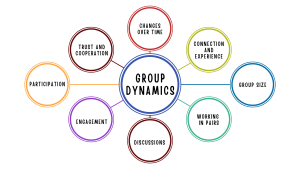Group Dynamics

Group dynamics are important in creating positive and safe learning environments. Group dynamics refer to the patterns of interactions, relationships, and behaviours that occur within a group of individuals. It involves the study of how people in a group influence and are influenced by each other, and how their collective interactions shape the overall functioning and development of the group. Group dynamics can be observed in various contexts, such as classrooms, work teams, social clubs, and community organizations.

Group dynamics change over the length of time the group is together. Establishing connections and common experiences helps the group move from initial discomfort at the beginning to shared experience at the end. The first step is providing the opportunity for the learners to connect. Suggestions for initial introductions were included earlier in this document. If you have a large group, 4 or more, structure learning activities in pairs or small groups to complete the initial part of the activity in break-out rooms and then regroup to complete the activities. This will provide an opportunity for individuals to work together and members of the group have the opportunity to get to know one another.
Take a few moments and watch this short animation describing the concept of group dynamics (4 min).
When group dynamics are not good, several signs and challenges may arise within the group. Some examples of what it may look like when group dynamics are negative or dysfunctional include lack of communication, conflict and tension, low participation and engagement, lack of trust and cooperation, and decision-making challenges.
Slides # 18-22
